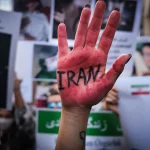
By Dr. David Wurmser
After years of oppression, Iranians are fighting back. To succeed, the West must support their struggle
This article was first published in The Telegraph on October 18th, 2022. Click Here to read the original article.
The murder of 22-year-old Mahsa Amini, a Kurdish woman arrested and tortured by Iran’s “morality police” for violating the country’s mandatory hijab law, triggered demonstrations in Iran that now in their fifth week with no signs of abating. Iran’s theocratic, militarised, authoritarian regime is under more domestic pressure than at any point since the Islamic Revolution of 1979.
It is, therefore, imperative to assess how the ayatollahs might finally be overthrown and what kind of government would follow. The key issue is whether today’s widespread protests constitute not merely a new Iranian “opposition,” but a real counter-revolutionary force.
Starting in Kurdistan province, but quickly spreading nationwide, the protests have increased in size, scope, and sophistication. The regime has responded brutally, but the ayatollahs also seem paralysed by the extent and fearlessness of the demonstrators. Supreme Leader Khamenei knows he has a serious problem, even as he tries to blame America and Israel.
The hijab protests are direct ideological challenges to the regime’s legitimacy, That is why the stakes are so high, far higher than in earlier protests such as in 2009 against fraudulent elections. Today, the regime itself is under assault.
The protests encompass all economic strata. It is not merely the revolt of educated, urban middle classes, but the “real Iran,” out in the countryside where Western journalists are rare. These average citizens, appreciating that having economic policies dictated by religious fanatics is less than optimal, have shouted “death to Khamenei,” rather than “death to America [or Israel].”
Ethnic and religious differences are also important. Iran’s exact ethnic mix is uncertain – minorities are reluctant to proclaim their status publicly – but the best guess is that Iran is only fifty per cent or slightly more “Persian,” with significant ethnic and religious minorities including Azeris, Kurds, Turkmen, Arabs, and Baluchis. There are meaningful numbers of Sunni and Sufi Muslims. Ongoing government discrimination against the Kurds and other minorities is particularly harsh.
Recent sympathy strikes by oil workers, amplifying their own economic grievances, are perhaps even more significant. Many remember that the oil workers’ 1978-79 rising against the Shah signalled that his days were numbered. If discontent in the vital petrochemical industry increases, shutting off significant production, Iran’s government would be crippled.
The Mahsa Amini demonstrations are therefore an accelerant to existing grievances. The interrelationships among the various discontents are complex, but ironically strengthen the resistance by significantly complicating the government’s ability to surveil and suppress the protests.
Contrary to regime disinformation, however, the uprisings are in fact completely spontaneous. That is bad news for the resistance because their communications across the country are totally inadequate, impeding agreement on day-to-day tactics, let alone broader goals. The good news about not having a centralised command structure is that the regime can’t stamp out the protests merely by eliminating a small number of leaders.
The demonstrators face hard questions which they must begin resolving soon if they hope to avoid becoming just another footnote to the history of Iran’s Islamic Revolution.
To become counter-revolutionaries, the protestors must decide on their ultimate objectives and how they intend to achieve them. Specifically, they need effective mechanisms to develop regime-change strategies and then put their plans into motion. To the extent resistance networks already exist inside Iran, regime opponents must put aside their own disagreements and either join those networks or form more effective ones. Otherwise, opposition political fratricide will doom the larger project. “Divide and conquer” is a concept well known to authoritarian regimes.
The outside world must also help, starting with offering tangible resources, particularly in communications capabilities. There is a lot of virtue signalling from Western capitals, which stokes the psyches of those doing the signalling, but accomplishes little more. For example, despite supportive rhetoric, the White House is still obsessed with rejoining the misbegotten 2015 Iran nuclear deal. Nor are the British, French or German governments, the agreement’s other Western partners, paying much attention.
This much change, immediately. Carpe diem.

John Bolton is a former US National Security Adviser